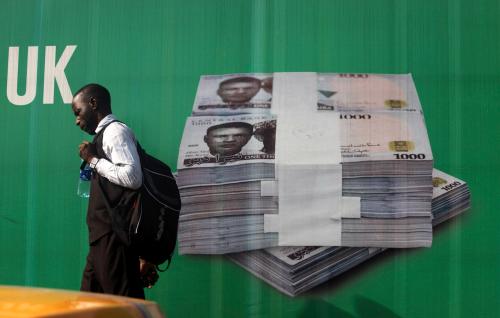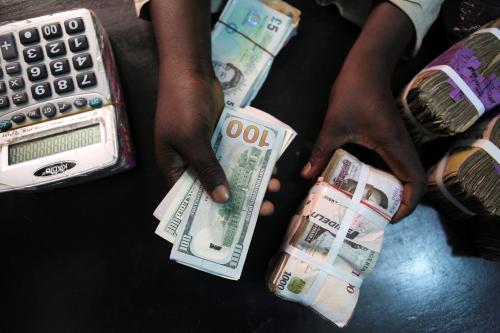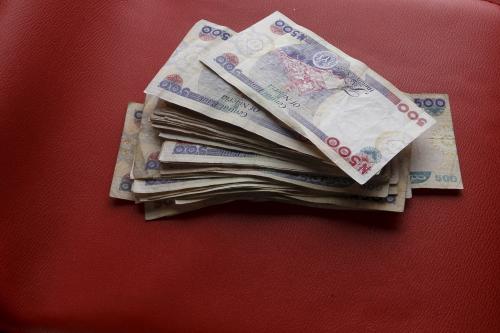The Africa Growth Initiative (AGI) Markets Monitor aims to provide up-to-date financial market and foreign exchange analysis for Africa watchers with a wide range of economic, business, and financial interests in the continent. Following the 2016 updates, the February 2017 update continues tracking the diverse performances of African financial and foreign exchange markets through the end of 2016. We offer our main findings on key recent events influencing the region’s economies: OPEC’s deal on crude oil output, Mozambique’s bond payment default, and Nigeria’s support of the naira.
Rise in fuel and metal prices boosted commodity prices in 2016
In 2016, commodity prices rose by 38.1 percent, according to the IMF’s all commodity price index data. The main drivers of the index’s growth were increasing fuel and metal prices, which grew by 66.1 percent and 35.8 percent, respectively, over the period. Oil prices generally climbed throughout the year, from $29.92 per barrel in January 2016 to $52.61 per barrel in December 2016. For oil-exporting countries that saw their fiscal balances deteriorate during the price slump in 2014 and 2015 (e.g., Angola, Cameroon, Chad, Gabon, Nigeria, and the Republic of the Congo) the gradual rise in oil prices could provide a modest boost to government revenues as they seek to diversify and acquire more reliable sources of fiscal revenue.
On November 30, 2016, the Organization of Petroleum Exporting Countries (OPEC) reached a deal to cut its members’ crude oil output by 1.2 million barrels per day (mbd) to 32.5 million mbd starting in January 2017 for six months (with the possibility for extension). Nigeria and Libya were exempted from the reductions, while other members of OPEC, specifically Saudi Arabia, Iraq, the United Arab Emirates, and Kuwait, will assume the largest cuts of the group. A meeting on December 10 resulted in additional reductions totaling 0.6 mbd by Saudi Arabia, Russia (a non-OPEC member), and 10 other non-OPEC countries. While this agreement indicates that oil prices could continue to rally in the near term, the degree to which prices will rise (or fall) in 2017 will be affected by compliance by OPEC members, Nigeria and Libya’s production levels, and a potential rise in shale production.
The IMF’s metal price index also increased in 2016—led by base metals iron ore (exported by Liberia, Sierra Leone, and South Africa), copper (exported by the Democratic Republic of the Congo and Zambia), zinc, tin, lead, nickel, and aluminum—due to robust demand from China’s construction industry and expectations of higher demand from the U.S. for infrastructure projects following the 2016 presidential election. Precious metals have also increased throughout 2016, although prices for gold (exported by Burkina Faso, Ghana, Mali, South Africa, and Tanzania) fell following the U.S. presidential election on the expectation of U.S. increased fiscal spending. Agricultural commodities have grown by 7.3 percent in 2016, although gains were not consistent across products and varied over the year. For example, in the first half of 2016, the prices of sugar and pork increased substantially, while barley, oranges, palm oil, and soybeans also made gains. In the second half of the year, however, grains, pork, soybeans, and cocoa experienced major declines in their prices, leading ultimately to the modest gains for agricultural goods in 2016. 

Low growth and currency depreciations led to African equity market downturns
The MSCI Emerging Markets Index increased by 11.3 percent in dollar terms over the period January to December 2016, while the corresponding African frontier markets index (which excludes South Africa) did not fare as well, declining by 7.4 percent over the year (see Figures 3 and 4). Currency depreciations as well as low economic growth experienced by some of the continent’s major economies contributed to the underperformance of several stock exchanges. The Nigerian and Ghanaian equity indices faced the most significant losses, 37.7 percent and 23.5 percent in dollar terms, respectively, with both countries’ stock exchanges decreasing as the value of their currencies declined against the dollar. South Africa’s equity index, on the other hand, grew in dollar terms by 11.0 percent in 2016 as its currency strengthened against the dollar, and it avoided potential credit rating downgrades during the year. Kenya’s and the West African Economic and Monetary Union’s BRVM equity indices experienced modest declines over the period. Despite Kenya’s relatively high economic growth in 2016, foreign investors’ concerns over the potential for violence surrounding the upcoming August 2017 elections led to the Nairobi Stock Exchange’s decline in 2016.


2016 saw declines for African and global bond spreads
African and global emerging market bond spreads fell by approximately 152 and 81 basis points, respectively, in 2016, suggesting that the perceived relative riskiness of African and global emerging market bonds decreased considerably over the course of the year (see Figure 5). The gap between the two spreads also narrowed. In comparison to the U.S. 10-year Treasury bond rate, the African bond index’s yield was 415 basis points higher at the end of 2016, down from 567 in early January, while the global bond index’s yield was only 365 basis points higher, down from 446 at the beginning of the year. Among a select group of African countries for which bond spread data exists, nearly all experienced a decline in bond spreads during 2016. The exception was Mozambique, which saw its bond spread climb steeply by 799 basis points, reflecting extremely weak market confidence following recent issues regarding the country’s debt (see Figures 6 and 7).



Mozambique’s economic crisis—which was exacerbated by a withdrawal of IMF and other donors’ financing following the revelation of $1.4 billion in secret government loans last year—continues to worsen. In October 2016, the Mozambican government announced that it would not be able to service its external commercial loans. Instead, it would work with creditors to restructure its debt in the hopes of reaching an agreement by the end of the year—although no formal talks were arranged at the time. On January 18, 2017, the government failed to remit a coupon payment of approximately $60 million for its $727 million in eurobonds that it issued in March 2016. Although the government was afforded a 15-day grace period, it still failed to settle the payment. According to Bloomberg, some observers argue that the government strategically defaulted to compel bondholders to negotiate a restructuring of the debt. As a result of the missed payment, Standard & Poor’s (S&P) downgraded Mozambique’s credit rating to “selective default,” (see Table 1). Bondholders argue that they will not enter into formal talks with the government to restructure the debt until it commits to an IMF program and an independent audit of its debt. The IMF has equally called for an investigation into government borrowing before it will provide additional assistance to Mozambique. A report by auditing firm Kroll on the government’s debts is expected to be released in February 2017.

South Africa’s rand appreciated as the Egyptian pound tumbled
South Africa’s rand, Zambia’s kwacha, and Somalia’s shilling were Africa’s best-performing currencies in 2016, with spot returns increasing by 13.2 percent, 11.1 percent, and 8.9 percent for the year, respectively (see Figure 8). Despite the rand’s gains in 2016, it experienced some volatility in response to the U.K.’s Brexit vote to leave the European Union, the election of U.S. President Donald Trump, and several sovereign credit rating reviews, as seen in Figure 9. In Zambia, recovering copper prices and monetary policy tightening helped bolster the exchange rate after 2015 saw a massive depreciation in the kwacha. Somalia’s shilling also strengthened against the dollar in 2016 due largely to remittance inflows. The dollarized economy plans to print its own currency in early 2017.
At the same time, spot returns for Mozambique’s new metical, Nigeria’s naira, and Egypt’s pound declined in 2016 by 32.8 percent, 36.8 percent, and 56.8 percent, respectively. The Mozambican metical depreciated by approximately 40 percent against the dollar in the first nine months of 2016 due to market and structural factors, but after monetary policy tightening in October 2016, it appreciated by nearly 8 percent, indicating a potential rebalancing of the foreign exchange market. In Nigeria, the naira fell by almost 40 percent following the end of its peg to the dollar in June 2016, however, observers say the government is still managing the currency at approximately 315 naira per dollar while the black market rate is 493 naira per dollar—approximately 60 percent more than the official rate. Furthermore, the marked devaluation of the Egyptian pound occurred in early November when Egypt’s central bank floated its currency to attract foreign capital and meet the requirements for a $12-billion IMF loan.













Commentary
AGI Markets Monitor: OPEC reaches oil deal, Mozambique defaults, and Nigeria manages its exchange rate
February 2017
February 16, 2017